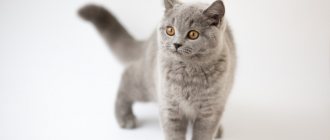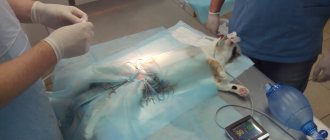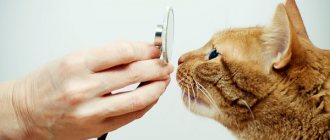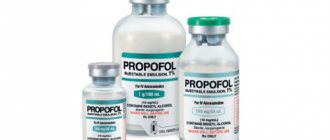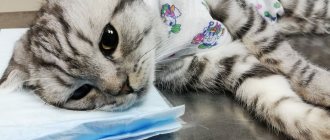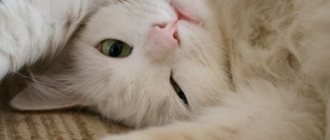Veterinarians often have to resort to surgical operations, without which it may be impossible to cure some pathologies. But often it is not even the operation itself that is particularly difficult! The fact is that anesthesia for cats, without which it can be difficult and even dangerous to do anything with an animal, should be prescribed only by an experienced and competent specialist. Otherwise, the outcome of the intervention will be sad.
Is anesthesia harmful?
There are many myths surrounding veterinary anesthesia. This is due to the fact that until the mid-90s, heavy drugs equated to narcotic drugs were used for operations. After a dose of such anesthesia, the animal could not always recover from anesthesia correctly. At that time, the percentage of cases where complications occurred was quite high - one in ten.
Today, veterinary medicine has stepped forward, and safer drugs are used for operations. A gentle effect on the body allows you to quickly remove the cat from anesthesia without harming it with aggressive “chemistry”.
The owner should take into account that the new drugs are more expensive than those used before. Therefore, if you are offered two types of anesthesia before the operation, do not skimp on your pet’s health and choose the more expensive one. The cat will be able to recover from such anesthesia faster and easier.
Modern drugs for anesthesia of cats
At CityVet veterinary clinics, doctors systematically undergo internships and advanced training courses in the field of anesthesiology. In our work, we use modern anesthesia drugs that have passed all the necessary tests and are certified for use in anesthesia for cats. Among general anesthesia, we give preference to drugs based on propofol, medetomedine, isoflurane, zolazepam and tiletamine.
What anesthesia is best for cats? No anesthesiologist can give a definite answer to this question. All drugs are selected taking into account the physiological and breed characteristics of the animal, age, based on the results of the preoperative examination and the surgical plan.
Gas anesthesia for cats is one of the safest means of general anesthesia today. The main drugs for inhalation anesthesia are isoflurane and sevoflurane. Drugs for inhalation administration have very little effect on the cat’s internal organs, are less toxic and are used by veterinary anesthesiologists for severe concomitant diseases (for example, cardiovascular pathology).
When seeking surgical help at our clinics, you can be sure that your cat is under the careful supervision of qualified specialists. We recommend that all animals requiring surgical intervention undergo preoperative examination and do not refuse to place the cat in the hospital after completion of the operation. By listening to our advice, you will be confident in the health of your pet, because your cat will receive high-quality medical care without consequences for its body.
Possible risk
Regardless of what drug is used, the animal’s respiratory cardiovascular system is still stressed. The task of the anesthesiologist and surgeon is to minimize unpleasant consequences after surgery, so you should only contact reliable and trusted specialists.
The veterinarian must examine the animal and select the optimal drugs for anesthesia. Problems and complications after surgery most often occur as a result of using inappropriate anesthesia for a particular animal.
Why is anesthesia needed?
Pet owners are often very concerned about veterinary procedures (castration, sterilization, oral debridement, removal of small skin growths) that rely on the use of general anesthesia. This article will provide an opportunity to explain what the benefits are and what the risks are when administering anesthesia to our pets.
The word anesthesia comes from a Greek word that means “lack of sensation.”
Anesthesia is achieved by administering drugs that suppress the function of the nervous system. During general anesthesia, the patient loses consciousness for a short period. During this unconscious state, muscle relaxation and complete loss of pain occur. Other types of anesthesia include local anesthesia, such as numbing a localized area of skin or tooth, and spinal anesthesia, such as an epidural block, which numbs a specific part of the body.
Preparation
Preparation for surgery includes two stages: examining the patient and preparing everything necessary.
Survey
Before the operation itself, the cat must be examined by a veterinarian. During the examination, pulse, blood pressure and body temperature are checked. The doctor also feels the cat’s stomach and checks the oral cavity.
Blood and urine tests are collected. A blood test for biochemistry is necessary in order to detect hidden diseases that tend to manifest themselves after the body is exposed to anesthesia.
Ultrasound examination for internal pathologies is also practiced. This measure will help prevent your pet from being placed on the surgical table again.
Elderly animals are also recommended to undergo cardiac ECHO.
Preparation
If you have a planned operation, such as sterilization, rather than an urgent one, it is advisable to plan it in the morning. The owner must also arrange his schedule so that during the entire time the cat is recovering from anesthesia, there is an opportunity to care for it.
The cat is on a fasting diet before surgery, so do not feed your cat 12 hours before the procedure. The water must be removed 10 hours before surgery.
If you do not arrange such an “unloading”, food in the stomach can cause nausea during surgery, which is unacceptable.
If the operation is performed in a clinic, ensure comfortable transportation. It is best if transportation takes place not in public transport, but in a car. It is also possible to perform surgery at home. To do this, veterinarians visit your home; however, this method has its drawbacks. In an unexpected situation, the doctor will not have all the necessary equipment. It is also difficult to ensure complete sterility at home.
If it is possible to take the cat to the hospital, perform the operation only there.
Prepare:
- Hard box. You can bring a cat to the clinic in a carrier, but you cannot put a cat in there under anesthesia;
- A blanket in which the box will be wrapped;
- Several diapers to put on the bottom;
- Oilcloth;
- Eye drops.
Aftercare
The likelihood of injury or other complications under constant supervision is reduced to almost zero. For the safety of your mustachioed pet, take a few days off or vacation during the postoperative period.
Drink
Drinking on your own is prohibited for the first 3-4 hours. Due to a violation of the swallowing reflex and severe drowsiness, the pet runs the risk of choking while swallowing or involuntarily falling asleep right in the bowl.
Wait until the stiffness disappears and the animal can hold its head up on its own. Until this time, feed him in small portions through a pipette or syringe without a needle. This will protect against dehydration and drying out of the mucous membranes.
Feeding
If fluid loss is unacceptable, then fasting on the first day is quite acceptable. Wait until the animal has completely recovered from the anesthetic and shows interest in food.
With the return of coordination, offer your pet liquid dishes (broths, watery cereals). Such light meals are digested faster, helping to avoid constipation. You will have to temporarily stop dry feeding. If your pet is not used to regular food, then use pouches and canned soft food.
The temperature of the food should be at room temperature. It is useful and safe for the gastric mucosa. The frequency of feedings will have to be increased and portions reduced. You need to return to your usual regimen and volumes very smoothly to avoid stress on the gastrointestinal tract.
Seam processing
On average, it takes 7-10 days for wounds to heal. Until this time, you will have to protect them from damage, getting wet and suppuration. The seams must be dry and clean, so additional processing is best avoided. The use of ointments and other drugs in liquid form inhibits regeneration and is only permissible as prescribed by a veterinarian.
How does a cat go to the toilet?
Due to the loss of control over defecation and urination in the first hours and even days, the pet may walk under itself. Be sure to put moisture-resistant diapers in the bed and change them immediately after bowel movements.
During the entire rehabilitation period, there should be a tray next to the bed. With poor coordination, it is very difficult to relieve oneself accurately, so searching for a toilet will only make the situation worse. Temporary difficulties will disappear when sensitivity returns to the hind legs.
When can you go for a walk?
Quarantine will have to be observed for at least 14 days. There are many dangers on the street: ticks, viruses, bacteria, helminths, fleas. Infestation with parasites or infection can lead to inflammation of the wound and deterioration of the general condition.
The risk of infection at home is lower, but still remains. For prevention, the animal is sometimes given 2 injections of antibiotics. The first is done at the end of the procedure, and the last - two days later.
How does the cat feel?
Some owners worry that the cat will feel pain during surgery. It's a delusion. A number of drugs are used for anesthesia, which are aimed not only at “euthanizing”, but also at weakening the muscle tone of the animal. It happens that a cat can come out of anesthesia earlier than expected, sometimes on the operating table. Even in this case, the animal will not feel anything, thanks to drugs that “turn off” sensitivity.
Can you describe the technique for administering a typical anesthesia procedure for a domestic cat?
All patients undergoing anesthesia are weighed upon admission and undergo a thorough pre-anesthesia examination, which includes examination of the chest, palpation of the abdomen and assessment of gum color and skin turgor (checking hydration status and confirming good circulation).
After checking the patient's clinical status, additional diagnostic tests are performed, such as echocardiography, blood or urine tests, blood pressure measurements, electrocardiograms (ECGs), or chest or abdominal x-rays as needed. These manipulations must be performed before administering any anesthetic drugs.
“With balanced anesthesia, the patient receives a combination of sedatives and anesthetics that suits their individual needs.”
In the vast majority of cases, a method called “combined anesthesia” is used. With combined anesthesia, the cat receives a combination of sedatives and anesthetics that suits its individual needs. The most common combination is pre-anesthetic administration of a combination of sedative and analgesic drugs, which are administered as a preliminary injection (premedication), and then induction of anesthesia is administered using special pharmacological agents. Induction of anesthesia is carried out by administering a special drug.
The level of anesthesia during surgery is maintained using a gas mixture mixed with oxygen,
or a special maintenance narcotic drug administered intravenously continuously at a given rate or by introducing small boluses of the drug as needed. To ensure precise delivery of the anesthetic gas into the airway, a special breathing tube called an endotracheal tube is inserted into the cat's breathing tube or trachea. This process is called tracheal intubation.
In addition to delivering gas to the lungs, the endotracheal tube seals the airway so that the patient cannot accidentally aspirate fluid or other foreign materials into the lungs while unconscious and unable to swallow.
Duration of anesthesia
The amount of time a cat spends “sleeping” largely depends on the type of substance administered, as well as the method of application. Simple surgical procedures, such as castration or dental surgery, are performed using short-term medications. After such anesthesia, the cat comes to its senses faster. Sometimes awakening happens while still in the clinic or on the way home.
Longer-acting drugs are used for complex operations. Anesthesia in this case lasts from two to 8 hours. The speed of recovery from “sleep” largely depends on the individual characteristics of the body.
After the operation, you need to ask your veterinarian how long the normal recovery from anesthesia lasts in a particular case.
The effect of anesthesia on the animal's body
Drugs that put a mustachioed patient into artificial sleep have a depressing effect on the brain’s cortical centers. They minimize sensitivity, but at the same time destroy nerve fibers and negatively affect the functioning of the cardiovascular system. The result of exposure to toxins is often hallucinations, blurred vision or hearing, headaches, and sleep destabilization.
As a rule, such effects disappear 2-4 hours after surgery. If an animal is diagnosed with a cardiac disorder, anesthesia often causes arrhythmia, which can last up to 2-3 days.
Veterinarians use not too strong substances to induce anesthesia.
Typically, veterinarians use a gentle anesthesia to remove the testes, which is different from traditional general anesthesia. It begins to act 10-30 minutes after administration. The dose is calculated based on the medical history. Dosage is also affected by body weight and age. A side effect of using the medicine may be vomiting, but this is a normal reaction of the body to toxins, and therefore you should not be afraid.
In this video, veterinarians tell you how to care for a cat during the postoperative period.
Anesthesia and eyes
The cat's body is designed in such a way that while under anesthesia, cats' eyes remain open. This does not mean that the animal can see everything around during the operation.
To prevent the mucous membrane of the eye from drying out, the veterinarian will advise you to buy special eye drops. Not vitamin solutions and medications that relieve redness, but ordinary drops that prevent the cornea from drying out. They need to be dripped into the cat during surgery, as well as periodically during recovery from anesthesia.
When instilling, you need to press the upper and lower eyelids, simulating blinking, because the cat's eye itself will not be able to distribute the solution throughout the mucous membrane.
Good to know
- Anatomy and physiology of the liver in cats (general information, structure, vascularization, innervation)
- The structure and functions of the thyroid gland in cats (anatomy and physiology)
- Measuring blood pressure in cats before performing procedures under general anesthesia
- Current role of dexmedetomidine in clinical veterinary and medical anesthesia and intensive care
- Dynamic testing of thyroid function in cats
- Gabapentin in cats and dogs (all pros and cons, indications, contraindications, doses, features of use, instructions for use)
- Information content of hematological and echocardiographic preoperative screening indicators
- Historical background on hyperthyroidism in cats
- Hyperthyroidism in older cats
- Cardiac hypertrophy in domestic cats
- Analysis of anamnestic data during preoperative examination of small domestic animals
- Study of anamnestic data in cats that require manipulation under general anesthesia
- Method for measuring blood pressure in cats
- ICD in cats (diagnosis and symptoms)
- Hyperthyroidism is suspected, but serum T4 concentration is normal
- Acute gastroenterocolitis in dogs (etiology, pathogenesis, diagnosis and treatment)
- Reducing mortality during anesthesia is an important task of veterinary anesthesiology
- Thrombosis in cats (general information, etiology, pathogenesis, clinical picture, diagnosis and treatment)
- Urolithiasis of small animals (etiology, pathogenesis, diagnosis and treatment)
- Congestive cardiomyopathy in cats (What is it? How to protect your pets)
- Gastrointestinal tract in dogs (anatomy and physiology)
- Levofloxacin in pets
- Concentrations of total and free thyroxine in cats (T4 hormone)
- Surgical treatment for hyperthyroidism in cats
- Treatment and prevention of urolithiasis in animals
- Urinary tract stones in cats and dogs (causes and mechanisms of formation)
- Liver lipidosis in domestic cats (symptoms and treatment)
- Performing laboratory tests in cats with hyperthyroidism
- Treatment of hepatolipidosis in domestic cats
- Pathogenesis and colloid theory of stone formation in urolithiasis
- What preparation is necessary for a cat to undergo general anesthesia?
- Causes of stone formation in dogs and cats
- Ondansetron for dogs (mechanism of action, blockade of serotonin receptors)
- Urolithiasis in Russia (urolithiasis). Scourge of modernity
- Acute gastroenteritis in dogs (pirchinas, pathogenesis, diagnosis and treatment)
- What function does the liver perform in the body of animals and humans?
- Misdiagnosis of hyperthyroidism based on falsely high serum total T4 (or free T4) concentration
- Drugs for the treatment of hypertension associated with hyperthyroidism in cats
- Primary Cardiomyopathy in Cats (History, Causes, Pathogenesis)
- Pharmacological treatment of cats with hyperthyroidism
- Endogenous hyperthyroidism in cats (causes, definition, characteristics)
- Monitoring during anesthesia in cats (Why is this necessary?)
- Methods of thoracic radiography in cats during pre-anesthesia diagnosis
- Preoperative assessment of the physiological status of the animal’s body
- The role of additional diagnostic methods before anesthesia in cats
- ECHO examination in cats before planned interventions using anesthesia
- Echocardiographic diagnosis of myocardial diseases in cats
- Carrying out electrocardiographic diagnostics in cats
- Why is etamzilat prescribed?
- Performing a physical examination during surgery in cats
- Physiology of the thyroid gland in domestic animals
- The role of cardiac evaluation as part of the preoperative workup in cats
- Description of the thyroid gland (history and functions)
- The role of animal examination and clinical examination during preoperative screening examination
- Information content of palpation of the thyroid gland in cats
- Use of the antibiotic cefotaxime
- Instructions for the use of propofol in dogs and cats and other animal species
- Prevalence of liver disease in cats
- Restrictive myocardial diseases in cats (definition, diagnosis and therapy)
- Heart murmurs in cats (How to interpret? Diagnostic value of this symptom?)
- Symptoms of urolithiasis in pets
- The state of internal organ systems in healthy dogs
- Radioactive iodine therapy for cats with hyperthyroidism
- Tiletamine and zolazepam are a drug for non-inhalation anesthesia in dogs and cats.
- What thyroid hormones circulate in the blood plasma of animals?
- Informativeness of determining thyroid-stimulating hormone in cats
- Ceftriaxone is a cephalosporin group of antibiotics
- Ultrasound technique of the thyroid gland in domestic cats
First hours
After the administration of anesthesia, the first day is considered critical. At this time, it is necessary to constantly be near the animal and observe its condition.
After coming home, the cat should be placed in a soft and warm place. Make sure that your pet is not exposed to drafts, and also isolate the “bed” from other animals in the house. Keep children away from the cat's resting place.
You can't put a cat on a hill. When he wakes up from anesthesia, he will not have full control of his movements and may fall. Therefore, the bed needs to be arranged on the floor. Place an oilcloth under the bed, as the cat will not be able to control its needs at first. And periodically you will need to clean up after it.
The cat should be laid down so that the stitches after the operation are in the most relaxed position. The cat should not pull or rub anything.
After abdominal surgery, your cat will need to wear a blanket. This will protect the stitches from contamination and keep them safe when the animal wakes up and tries to examine the scar.
Caring for a cat after sterilization
The veterinarian who performed the operation will tell you what proper care should be for the animal after sterilization. After arriving from the clinic, place the cat on a soft bedding covered with a sterile white cloth. Place the place or cat house on the floor or any other flat surface, but not on a hill, not in a draft or near heating devices.
When recovering from anesthesia, the cat does not control its reflexes. Sudden movements, jumping from heights, or accidental behavior can cause surgical sutures to come apart.
Important! During the first 24 hours, carefully monitor your cat’s behavior and condition. Do not leave the animal unattended.
In case of hypothermia, cover the animal with a blanket or warm blanket. Place a warm heating pad or plastic bottles filled with hot water under the backrest.
Awakening
In most cases, the cat comes to its senses within 4-6 hours after arriving home. When the cat wakes up, it will immediately try to get up. It is important to ensure that the animal does not harm itself with sudden movements, since some pets immediately try to run away, not understanding the source of the discomfort.
If the cat tries to get up, offer him water. Avoid long “walks”; carefully place your pet back on the bed every time he tries to get up.
It is important to understand that the behavior of a cat during recovery from anesthesia is an unpleasant sight. The animal looks pitiful, it cannot control its body, and its legs constantly bend. This situation is normal, so you should not try to help your cat unnecessarily. It is better to provide her with peace and monitor her condition.
Some animals may show aggression, this is also normal. The cat does not understand what happened to him and tries to defend himself in the style of a predator - to attack an imaginary offender.
Try not to irritate your pet again. The room should be quiet and calm. Otherwise, the cat will try to hide from intrusive people.
Trichobezoars: ingesting their own hair
For 7-14 days, depending on the doctor’s recommendation, the cat walks in a blanket or collar after sterilization. This is necessary so that she does not lick the seam. But as a result, the cat is deprived of the opportunity to wash its entire body and tidy its fur.
After the blanket is removed, the cat begins to lick itself furiously. All this time the wool fell out, became tangled under the blanket, but was not renewed. As a result, the animal swallows a huge amount of its own fur. Of course, if you have a Sphynx or Cornish Rex, there is nothing to worry about. And if the cat is a long-haired breed (Maine Coon), it must be combed with a furminator after you take off its clothes.
Trichobezoars, hairballs, are manifested either by periodic regurgitation (vomiting) or by the same constipation (see point No. 1).
Drink
You cannot feed your cat after surgery, but you must give water. To avoid dehydration, start giving your pet water immediately after waking up. In the first hours, she will not be able to drink on her own, so it is necessary to drop a few drops of water into the cat’s mouth every half hour.
Until the animal can move confidently, it must be given water on its own. Use a syringe without a needle, dropping a teaspoon of liquid every hour.
There is an opinion that a bowl of water should be left near the bed. However, this should not be done if the owner has the opportunity to water the cat manually. The fact is that a disturbed swallowing reflex will not only prevent the pet from getting drunk, but can also cause the cat to choke or drink through its nose.
Also, the danger of a bowl next to the bed is that the cat suddenly becomes drowsy after anesthesia. He can fall asleep with his face in a cup.
How cats go under anesthesia
In addition to assessing the external condition, the anesthesiologist takes into account the stress level of the mustachioed patient. It is permissible to use premedication - a preparatory procedure that includes the administration of sedatives.
Speed of "falling asleep"
Intramuscular or subcutaneous premedication is carried out 10-15 minutes before the anesthetic is administered. In most cases, animals are “euthanized” with Propofol. The speed of falling asleep varies from person to person, but on average it takes 10-30 minutes.
It is important to understand that the anesthetic is necessary only so that the mustachioed patient does not interfere with the surgeon’s work. It does not eliminate pain. Analgesics, which are calculated separately, cope with this task.
State of immobility
Immobility is achieved not only thanks to the anesthetic, but also with the help of muscle relaxants, which relax the muscles. To assess the condition of the body, the mustachioed patient is connected to special sensors. Modern equipment independently monitors any deviations. In emergency cases, it starts the artificial ventilation system to avoid suffocation when pulmonary activity is low.
The cat is in a completely immobilized state for 1-3 hours. This time is enough to carry out most operations.
Feeding
You should not try to feed your cat as soon as she wakes up. The body is still in a sluggish state, so food that is not properly digested can cause constipation. The cat should not be allowed to strain while going to the litter box, as this may cause the seams to come apart.
At first, the cat will not be interested in food. This is fine. Don't try to force feed her. A weakened body will not be hindered by a day of hunger strike.
Feeding can begin only then. When signs of impaired coordination of movements disappear. The first food a cat eats should be liquid. It is important not to offer your cat unfamiliar food after surgery. This should be your usual food at room temperature.
The best option is a lump of pate, which can be offered to the cat by bringing it to its face. For the first time, half a teaspoon will be enough.
The cat will begin to feel hungry and ask for food only the next day. You need to feed her semi-liquid food in small quantities.
You only need to worry if on the third day after the operation the cat does not eat anything. In this case, you need to consult with the veterinarian who performed the procedure.
How long does it take for a cat to come to its senses?
As a rule, after surgery the cat can sleep for up to 3-5 hours. This is fine. Then she will be unsteady, she will have other oddities (she will refuse the treats that she loves very much, she will drink a lot). However, your favorite mustachioed beauty will come to her senses around the second or third day.
Important!
Until the cat returns to its previous life activities, it should under no circumstances be left unattended!
When to sound the alarm
To make recovery from anesthesia as smooth and comfortable as possible, provide all the necessary conditions. Also constantly monitor the condition of the animal:
- Measure your body temperature every two hours;
- Listen to the heart rhythm: there should be no pauses or sudden jumps in the heartbeat;
- Take care of your cat's eyes and inspect the mucous membranes of the mouth;
- If an external suture remains after surgery, treat it regularly;
- Follow all doctor's instructions (injections, wound treatment).
There are situations when the animal's condition worsens. In this case, you cannot hesitate.
Feel free to contact the doctor at any time of the day if something is wrong with your cat.
You should call your doctor immediately if you have the following symptoms:
- Respiratory disturbance: the cat wheezes, breathes shallowly, inhales are intermittent or shallow;
- The mucous membranes have changed color: they have turned red or blue, excessively pale;
- The pulse is difficult to hear or interruptions are heard;
- Body temperature has increased or decreased;
- The time allotted for awakening has passed, and the cat does not respond to touching its whiskers and nose;
- Any symptoms that seem unacceptable to the owner.
Lack of appetite
If a cat refuses to eat and drink on the first day after surgery, then there is no need to force it to do so, this is normal. The animal must be left alone and not interfered with in restoring its strength after the ordeal.
But if the cat does not eat or drink anything for three days or more, this is a complication and requires consultation with a veterinarian.
Feeding meat broth using a pipette or syringe is usually sufficient. But there are complications in which intravenous nutrition is resorted to.
Often cats change their tastes during the postoperative period, giving up previously favorite foods; this should not be a cause for concern. Your doctor may prescribe special vitamins for sterilized cats. There are several rules that must be followed for feeding your pet during the postoperative period:
- care must be taken to ensure that drinking water is always available to the cat;
- vomiting after eating is considered normal if the cat has not yet recovered from anesthesia;
- the amount of food must be limited; it is better to feed your pet more often, but in small portions;
- food should not be hard, as this can cause constipation and complications with the stitch.
The food should be soft, preferably a semi-liquid consistency; raw food is also not recommended to be given to the animal.
Inhalation anesthesia for rodents and ferrets
The most delicate pets at Alisavet are given inhalation anesthesia
All three stages of creating gas anesthesia are carried out in these animals. However, there are small peculiarities here.
Inhalation anesthesia for small rodents is also carried out after premedication. In hamsters and rats, a tube is not inserted into the trachea, so the gas mixture enters through a special mask.
Ferrets and large rodents (guinea pigs, rabbits) are first given premedication, after which an intravenous catheter is installed, and then a gas mixture is also supplied using special masks.
03/09/18 Anesthesia for rabbits. Inhalation (gas) anesthesia
Is inhalational anesthesia allowed for everyone?
There is always at least one contraindication for the use of any substance. And that's okay.
The veterinarian will NOT use inhalational anesthesia if your pet has:
- bronchial asthma;
- bronchitis and any lung diseases;
- any lesions of the trachea;
- increased intracranial pressure;
- traumatic brain injuries and in general any pathologies associated with the brain.
After a thorough preventive examination, a veterinary anesthesiologist may allow the animal to undergo inhalation anesthesia if:
- the pet does not have the above diseases;
- during laboratory testing, blood counts are within acceptable limits;
- there is no prohibition from a cardiologist after an ECG or ECHO (ultrasound of the heart);
- Gas anesthesia is indeed advisable (simple and quick procedures are sometimes performed under local anesthesia).
Inhalation anesthesia can be performed on examined pets at any age - both very young animals (kittens, puppies) and very elderly ones.
But you need to remember that only an anesthesiologist can decide what type of anesthesia to administer to a particular animal and what drugs to use - most often it also depends on the anesthetic risk (ASA scale), age, breed and scale of the operation.
